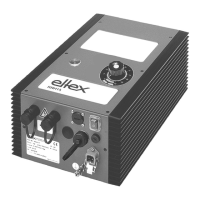BA-en-3018-2006_KNH18 9
• The IP 40 protection class applies only if the lid of the enclosure is
closed and the cable entries are covered, and this only in areas where
IP 40 protection class is sufficient.
• The site of installation must be dry and free of dust, if possible. Air cir-
culation above the cooling ribs must not be obstructed (see chapter 3.1
"Assembly of the high voltage generator”, page 11).
• When routing the high voltage cable observe all notes in chapter 3.3
"Installation of the high voltage cables”, page 12.
• The high voltage cable must be pushed up to the stop (90 mm) into the
cable inlet! The connecting area of the high voltage cable must be kept
clean (see chapter 3.5 "Connecting the high voltage cable to the gener-
ator and to the distribution box”, page 14).
• Disconnect and/or connect the mains cable on the socket only when
off-load (see chapter 3.7 "Connecting the supply voltage”, page 15).
• Connect or remove the bars only after the supply voltage to the high
voltage generator has been disconnected.
• Before activating the unit, the user must make sure that the unit has
been correctly installed and that the connections are properly made.
The supply voltage can then be switched on (see chapter 4 "
Opera-
tion”, page 17).
• Select the desired output voltage via the rotary button. High voltage
may also be present if the rotary button is turned fully anti-clockwise to
the stop (see chapter 4.2 "Use”, page 17).
• The generator must be checked regularly to ensure its proper function-
ing. The connections of the high voltage cables must be free of dirt and
other foreign matter (see chapter 5.1 "High voltage generator”,
page 18).
• When cleaning do not soak the bars and the high voltage cable in sol-
vent and do not damage the emission tips; allow the solvent to evapo-
rate completely before restarting the unit (see chapter 5.2 "
Charging
bars”, page 18).
• Check the units, the electrical wiring and the hight voltage cable at
regular intervals and before startup for any damage. Any damaged
components must be repaired profesionally or replaced before conti-
nuing to operate the units, or the bar or cable must be disabled.
• Make sure that the bars are clean at all times. Dirt results in malfunc-
tions and in premature wear of the units.
• The operation of the bars can generate ozone. The ozone concentra-
tion levels developing near the bars depend on many different factors
such as site of installation, bar current and voltage, air circulation, etc.,
and can therefore not be specified in general terms.
If the maximum allowable concentration of ozone must be observed at
the site of installation of the , the concentration must be measured on
site.

